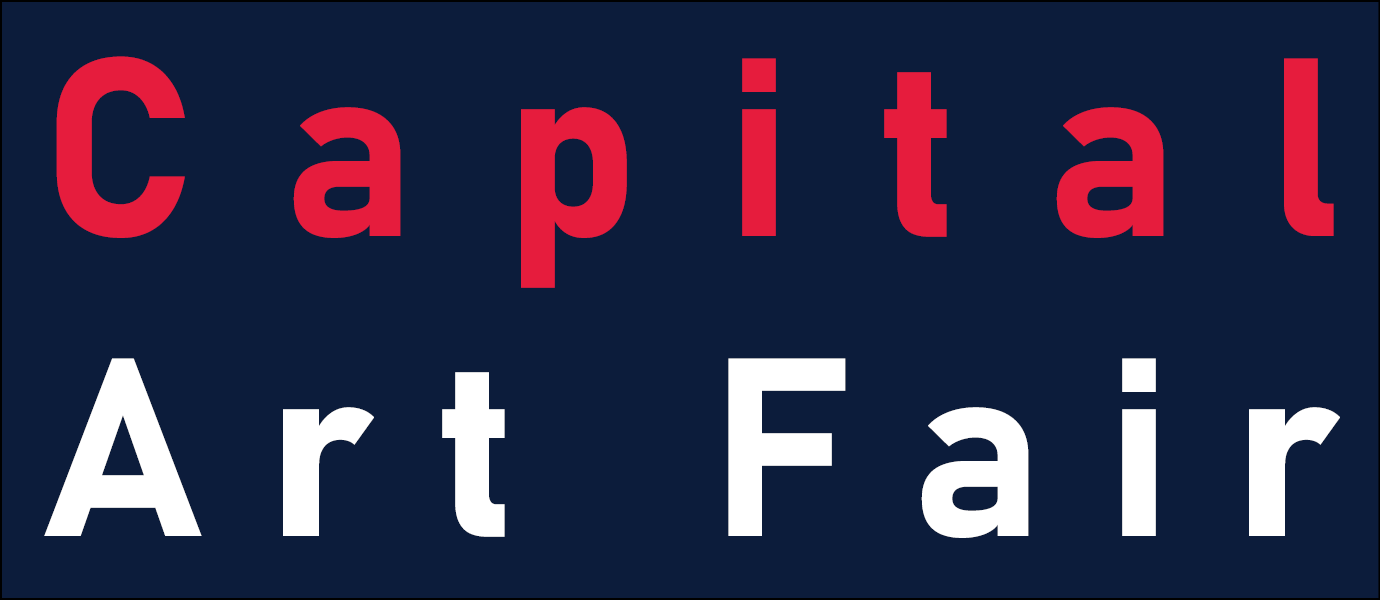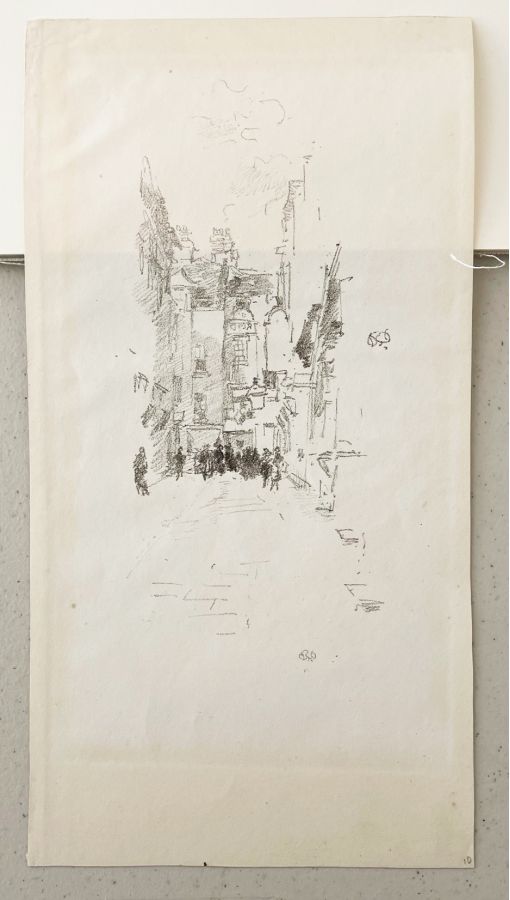Whistler, James A. M. THE LITTLE COURT CLOTH FAIR. Spink 22. Lithograph, 1887. A lifetime impression, one of 12 printed by Way and signed in pencil with the Butterfly.
Printed on Ivory colored wove paper without watermark. The sheet 11 9/16 x 6 inches. In very good condition with slight discoloration from the mat in the areas outside the mat window. Provenance: Collection of Otto Gerstenberg (see below) with his collectors stamp, Lugt 2785, the Secretary Montag's "M" and the inventory numbers 61248 KO5182 all on the verso; Horizon Gallery, Rockport, MA, with its label and annotations on the frame backing. Framed. Very rare.
The following are translations from the entry on Gerstenberg in Lugt:
Lugt 1921:
O. GERSTENBERG (born 1848), director of the Insurance Company "Victoria", lives in Berlin. Old and modern prints.
Otto Gerstenberg, born in Pyritz, studied mathematics and philosophy at the University of Berlin. After having been employed at the Prussian Statistical Office, in 1873 he entered the insurance company "Victoria" in Berlin as a mathematician-calculator, and became its director in 1888. He developed it in the following years and brought it up. to its present importance. Around 1900 he began to collect prints of which he now has a very large cabinet; as elders especially Schongauer, Dürer and Rembrandt, then Lucas de Leyde, Hirschvogel, van Dijck, Ostade and the French portrait painters. As modern it is necessary to point out, among the Germans »Greiner, Klinger, Leibl, Liebermann, Menzel, Stauffer-Bern; among the French, Corot, Daumier, Degas, Forain, Lepère, Manet, Meryon, Toulouse-Lautrec; among the English, Bone, Dodd, Goff, Haden, Strang; then an important work by Whistler and Goya and leaves by Rops and Zorn. Also has beautiful paintings.
Lugt 1956:
During the 1914-1918 war, the collectort had his collection transported to Switzerland and, when the war was over, he decided, quite reluctantly, to sell it. In the spring of 1922 the sale was concluded in Zurich with the merchants Gust. Mayer, of Colnaghi & C ° of London, and Mr. A. MacDonald, then a partner of Harlow & C ° of New York, who bought the set at a price corresponding roughly to the total prices paid by Gerstenberg. This was a large sum, because he had acquired several of his finest pieces in the big sales between 1900 and 1914 against the big enthusiasts of the time such as Morgan, Gutmann, Rothschild etc. It was Gaiser, of the firm H. G. Gutekunst in Stuttgart, who had generally carried out his orders in the sales. MacDonald believed he had a buyer for the set in America, but when the collection arrived there those hopes were dashed by a change in economic conditions. He then sold the parts separately.
We will get an idea of the importance of this collection by the following enumeration of the most beautiful pieces: among the Dürer, the Adam and Eve (from the Buccleuch and Hubert collections), the Saint-Eustache, the Mélancolie (from the collection Behaim, Dumesnil and Scholtz), the Knight of Death (from the Barnard and Hubert collections) and the Life of the Virgin series (from the St. Aubin collection); Dürer's work was almost complete. Quite remarkable was the Rembrandts' series, in which we note the Piece aux cent florins, sur Japon (collection Weber and Hubert), the Three Crosses, 1st state and 2nd state (collection Artaria and Hubert), the Little Tomb ( coll. John Wilson) and another proof on Japan, Death of the Virgin in Irstate (Josi coll.), St. Jerome, B. 103, unstead (Josi, Aylesford, Buccleuch and Hawkins coll.), the St. François (coll. Theobald); the series of portraits by Rembrandt was superb: Rembrandt himself drawing, B. 22, Ir état (from the Worlidge, Brit. Mus., Dighton and Theobald collections) and the same in the second state on Japan (Morrison collection), all the states of Clement de Jonghe, Jan Asselijn, Irtat (Josi, Aylesford, Buccleuch and Hubert coll.), old Haaring, 2nd state (same sources) and the young, 2nd state in Japan (Brodhurst and Lanna collection) , the Lutma in 1st state on japan (Josi, Aylesford, Baccleuch and Hubert collection) and a superb 2nd state (from the Firmin-Didot and Hubert collections), the Six in 3rd state (Ploos van Amstel collection); in landscapes: the three Trees (coll. Theobald), the three Chaumières (coll. Morgan and Lesecq des Tournelles), the Landscape with the tower, Ir état (coll. Aylesford, Holford and Hubert), the Campagne du peseur d ' gold, on Japan (Barnard, Holford and Theobald collection) and a State of Landscape with the drinking cow, on Japan (Theobald collection). Then a series of 51 Schongauer, including several of the first order, 8 of Hirschvogel, the portraits by van Dijck himself in first states (except D. 10 and 15, the most beautiful of the collection Theobald), beautiful series by Claude and van Ostade.
The purchase included neither the important modern prints that Gerstenberg owned, nor his beautiful prints by Goya, nor a few drawings by the latter and Rembrandt. Gerstenberg was an enthusiastic collector who passionately loved his collection. When in 1922 the buyers announced their decision to acquire his old prints at the agreed price, he could not contain his tears. He later consoled himself by developing his series of watercolors and drawings of the French school of the nineteenth century, and he managed to own a magnificent set of Delacroix, Daumier, Degas, Monet and, in general, the Impressionists. . We do not know, at the present time, what happened to this part of his collection, but it is feared that part of it was lost or destroyed in the offices of the insurance company "Victoria" in Berlin or in its property in Silesia during the Russian invasion in 1945. The Toulouse-Lautrec which had been evacuated to Denmark were sold out of court after the war from 1939 to 1945. Gertstenberg died ,very old in 1935.
The mark reproduced by us in L.2785 has rarely been used, but the origin of the prints is more easily recognized by the initial M, followed by a number (see L.1840c), inscription written in pencil, at the time of sale old prints, by Gerstenberg's secretary, called Montag.
THE LITTLE COURT - CLOTH FAIR
| Date | 1887 |
| Technique | Lithograph |
| Price | $18,000.00 |
| Exhibitor | Edward T. Pollack Fine Arts |
| Contact the Exhibitor | 617.610.7173 ed@edpollackfinearts.com |
| Buy From / See At This Exhibitor's Site | |



